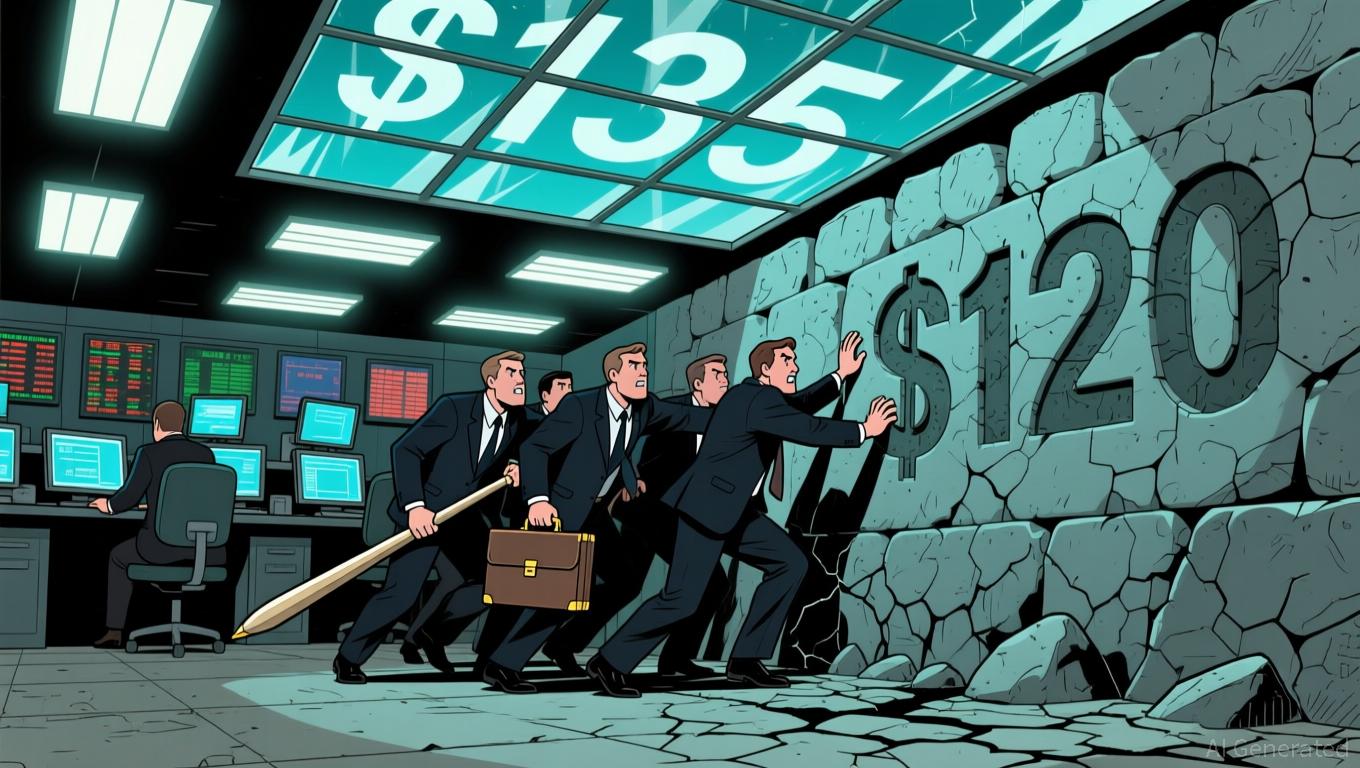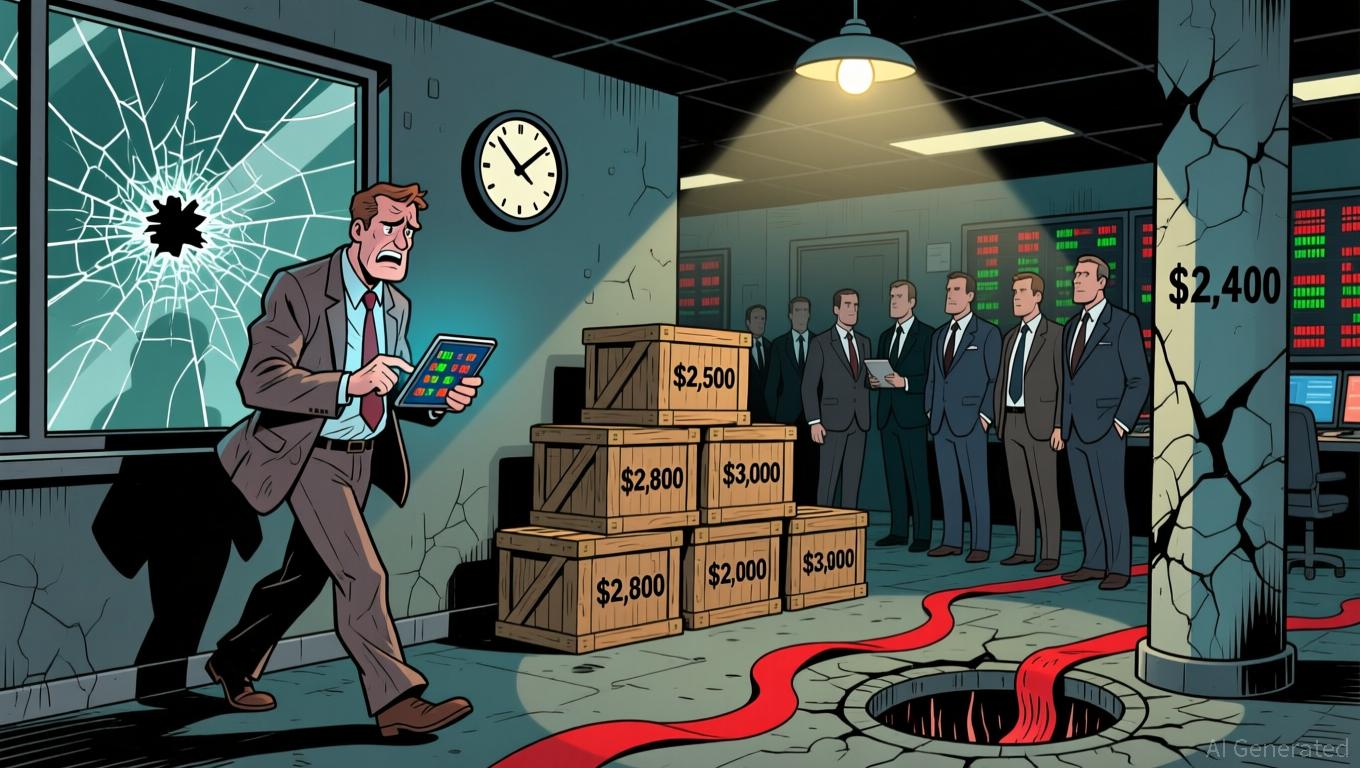Solana News Update: Solana ETFs Attract $476M While Death Cross and $120 Support Level Approach
- Solana ETFs attract $476M in 19 days, driven by Bitwise's 0.20% fee BSOL ETF with $424M inflows. - Technical indicators show a death cross and $120-$123 support test, with RSI at oversold 33 amid stagnant price action. - Institutional confidence grows via Franklin Templeton's fee-waiver strategy, contrasting Bitcoin/Ethereum ETF outflows of $5.34B. - Whale accumulation and on-chain growth hint at long-term buying, but $140 resistance remains unbroken despite ETF inflows.
Solana at a Critical Crossroads: Price, Institutional Flows, and Market Sentiment
Solana (SOL) is currently navigating a crucial phase as its value hovers near the $120 support level. Both analysts and investors are watching closely to see if the recent uptick in institutional interest can spark a recovery toward the $170 mark. Despite having dropped 30% from its recent high of $186, Solana’s spot ETFs have stood out against the broader market downturn.
Over a 19-day streak ending November 21, Solana ETFs attracted $476 million in inflows. The majority of this, approximately $424 million or 89%, came through Bitwise’s BSOL ETF, which has drawn investors with its competitive 0.20% fee and staking rewards. This strong institutional demand is in stark contrast to the outflows seen in Bitcoin and Ethereum ETFs, which lost $3.7 billion and $1.64 billion, respectively, during the same period.

Technical Analysis: Signs of Weakness and Potential Reversal
From a technical standpoint, Solana’s market structure appears fragile. For the first time since early 2023, a “death cross” has emerged, with the 50-day moving average falling below the 200-day average—a classic bearish indicator. The price has been confined to a downward channel since mid-September, facing resistance at $135 and finding crucial support between $121 and $123. Although buyers have managed to defend the $120 area, the Relative Strength Index (RSI) at 33 points to oversold conditions. Notably, recent candlesticks with long lower shadows suggest that buyers are stepping in aggressively at these levels.
Market observers, including analysts like Crypto Tony, stress that reclaiming the $130 level is essential to shift the short-term trend. If successful, the next significant barriers lie between $135 and $140.
Institutional Moves and On-Chain Trends
Institutional and large-holder activity paints a complex picture. The surge in ETF inflows has coincided with increased accumulation by major investors, even as prices have fallen. On-chain analytics from Santiment reveal a steady rise in both new addresses and active wallets, indicating early-stage accumulation despite a 49% drop in market value since September.
Meanwhile, Franklin Templeton has entered the Solana ETF arena, offering a fee waiver on the first $5 billion in assets under management—a move designed to mirror the success of Bitcoin ETFs. This approach highlights growing institutional confidence in Solana’s rapidly developing ecosystem, which has seen notable growth in transaction throughput, decentralized finance (DeFi), and meme tokens.
Price Action Lags Behind Institutional Interest
Despite the influx of capital, Solana’s price has yet to reflect this momentum. At $136, SOL remains below its 50-day exponential moving average, and futures open interest has remained flat as bulls struggle to overcome the $140 resistance level. Should the price fall below $120, a retest of the $70–$95 range could be on the horizon. Conversely, a sustained move above $144 would suggest a possible trend reversal. The disconnect between strong ETF inflows and lackluster price action raises questions about the durability of current demand, with some experts noting that retail investors often follow the lead of larger players.
Outlook: Can Solana Hold the Line?
As these factors play out, Solana’s future depends on continued institutional backing and the ability of buyers to defend key support zones. With daily ETF inflows exceeding $10 million and on-chain activity on the rise, reaching the $170 target remains possible—but only if the $120 support level remains intact.
Disclaimer: The content of this article solely reflects the author's opinion and does not represent the platform in any capacity. This article is not intended to serve as a reference for making investment decisions.
You may also like
XRP News Today: Abu Dhabi’s Green Light Establishes UAE as a Pioneer in Stablecoin Development
- Ripple's RLUSD stablecoin gains Abu Dhabi regulatory approval as UAE advances digital finance leadership. - ADGM's "Accepted Fiat-Referenced Token" designation enables institutional use for lending and cross-border payments. - RLUSD's $1.2B market cap growth reflects institutional demand, backed by USD reserves and dual blockchain operations. - UAE's ADGM-DIFC regulatory synergy attracts global fintechs , with Ripple expanding partnerships across Africa and Asia. - Regulatory milestones position RLUSD to
Ethereum Updates: Ethereum Drops to $2,800, Prompting Surge in Demand for ZKP's Hardware-Based Presale
- Ethereum's price fell below $2,800, triggering $6.5M liquidations and testing critical support levels amid declining on-chain demand metrics. - Institutional players like BitMine accumulated 3.62M ETH (~$10.4B) despite the selloff, signaling long-term bullish conviction. - ZKP's hardware-driven presale gained traction with $17M in ready-to-ship Proof Pods and Miami Dolphins partnership for privacy-focused sports analytics. - Mutuum Finance's $19M DeFi presale and ZKP's auction model with $50K wallet caps

Vitalik Buterin Supports ZKsync: What This Means for Layer 2 Scaling
- Vitalik Buterin endorsed ZKsync in late 2025, highlighting its "underrated and valuable" work alongside the Atlas upgrade achieving 15,000 TPS and $0.0001 fees. - ZKsync's zero-knowledge rollups and EVM compatibility enabled institutional adoption by Deutsche Bank , Sony , and Goldman Sachs for cross-chain and enterprise use cases. - The Fusaka upgrade aims to double throughput to 30,000 TPS by December 2025, positioning ZKsync to compete with Polygon zkEVM and StarkNet in Ethereum's Layer 2 landscape. -

The ZK Atlas Enhancement: Revolutionizing Blockchain Scalability?
- ZKsync's 2025 Atlas Upgrade achieves 15,000–43,000 TPS with sub-1-second finality, addressing Ethereum L2 scalability bottlenecks via Airbender proofs and modular OS. - DeFi protocols like Aave and Lido leverage ZKsync's $0.0001/tx costs to unify liquidity, while Deutsche Bank and Sony adopt its trustless cross-chain infrastructure for compliance and transparency. - ZK token surged 150% post-upgrade, with TVL hitting $3.3B and analysts projecting 60.7% CAGR for ZK Layer-2 solutions by 2031 amid instituti
